PICO(T) Question and Evidence-Based Approach: ABPM Implication
VerifiedAdded on 2022/08/20
|6
|1418
|14
Report
AI Summary
This report explores the application of Ambulatory Blood Pressure Monitoring (ABPM) in diagnosing hypertension through the lens of the PICO(T) framework. It contrasts ABPM with traditional blood pressure measurement methods, highlighting ABPM's advantages in identifying conditions like white-coat and masked hypertension, as well as nocturnal hypertension. The report emphasizes the effectiveness of ABPM in providing a comprehensive 24-hour blood pressure profile, enabling better management of hypertension and reducing cardiovascular complications. It concludes that implementing ABPM in evidence-based practice is crucial for healthcare professionals to improve hypertension diagnosis and patient outcomes.
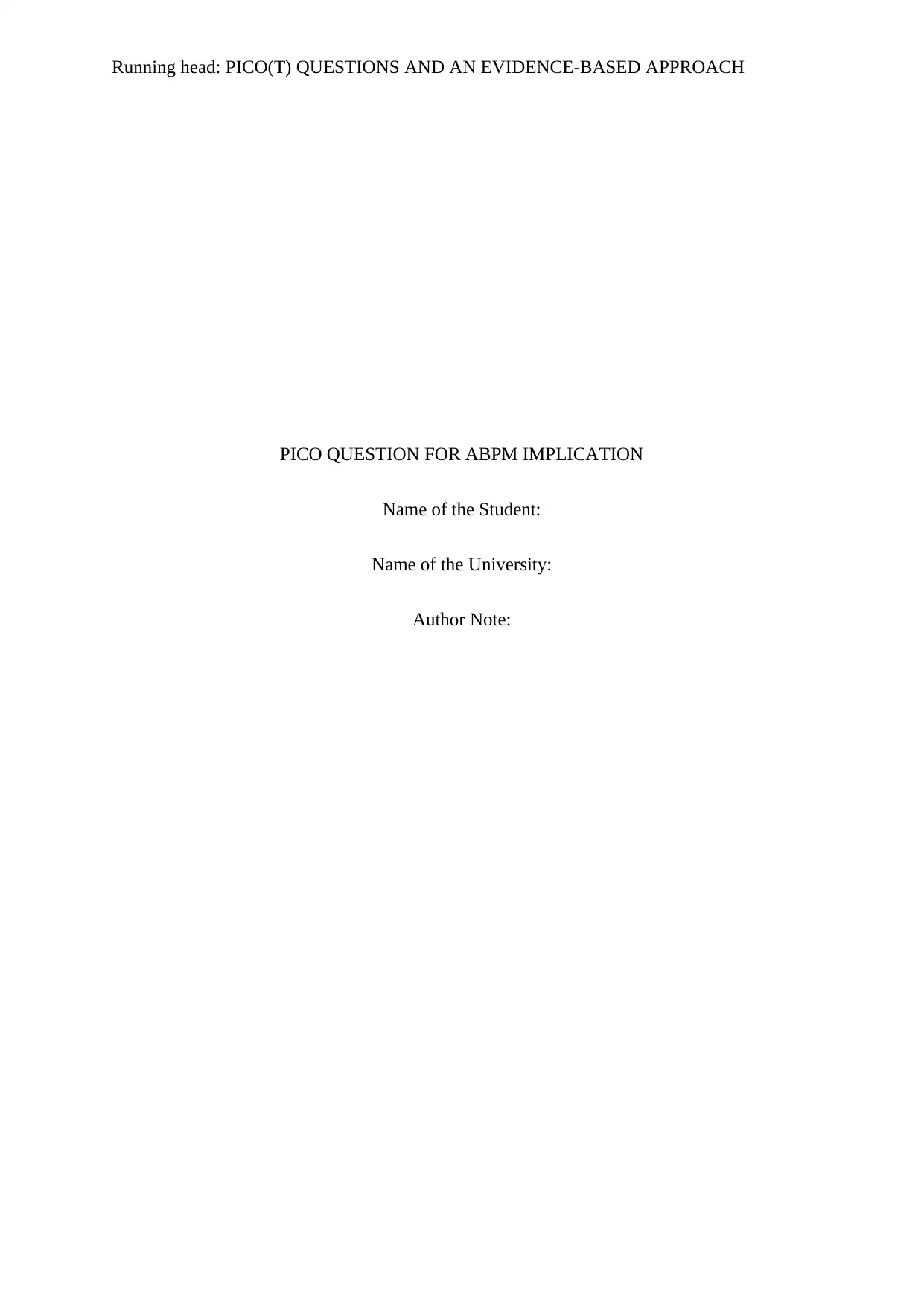
Running head: PICO(T) QUESTIONS AND AN EVIDENCE-BASED APPROACH
PICO QUESTION FOR ABPM IMPLICATION
Name of the Student:
Name of the University:
Author Note:
PICO QUESTION FOR ABPM IMPLICATION
Name of the Student:
Name of the University:
Author Note:
Paraphrase This Document
Need a fresh take? Get an instant paraphrase of this document with our AI Paraphraser
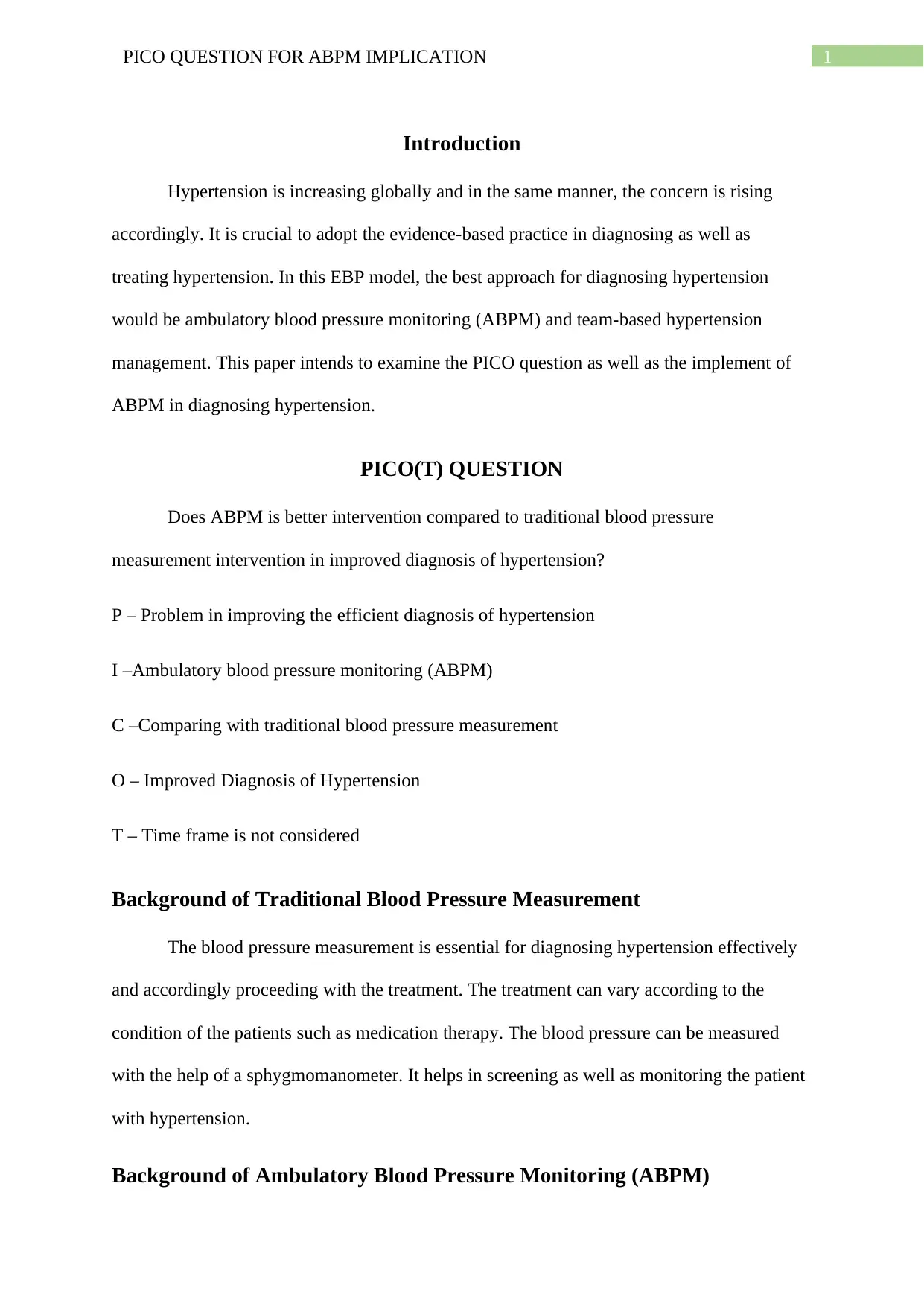
1PICO QUESTION FOR ABPM IMPLICATION
Introduction
Hypertension is increasing globally and in the same manner, the concern is rising
accordingly. It is crucial to adopt the evidence-based practice in diagnosing as well as
treating hypertension. In this EBP model, the best approach for diagnosing hypertension
would be ambulatory blood pressure monitoring (ABPM) and team-based hypertension
management. This paper intends to examine the PICO question as well as the implement of
ABPM in diagnosing hypertension.
PICO(T) QUESTION
Does ABPM is better intervention compared to traditional blood pressure
measurement intervention in improved diagnosis of hypertension?
P – Problem in improving the efficient diagnosis of hypertension
I –Ambulatory blood pressure monitoring (ABPM)
C –Comparing with traditional blood pressure measurement
O – Improved Diagnosis of Hypertension
T – Time frame is not considered
Background of Traditional Blood Pressure Measurement
The blood pressure measurement is essential for diagnosing hypertension effectively
and accordingly proceeding with the treatment. The treatment can vary according to the
condition of the patients such as medication therapy. The blood pressure can be measured
with the help of a sphygmomanometer. It helps in screening as well as monitoring the patient
with hypertension.
Background of Ambulatory Blood Pressure Monitoring (ABPM)
Introduction
Hypertension is increasing globally and in the same manner, the concern is rising
accordingly. It is crucial to adopt the evidence-based practice in diagnosing as well as
treating hypertension. In this EBP model, the best approach for diagnosing hypertension
would be ambulatory blood pressure monitoring (ABPM) and team-based hypertension
management. This paper intends to examine the PICO question as well as the implement of
ABPM in diagnosing hypertension.
PICO(T) QUESTION
Does ABPM is better intervention compared to traditional blood pressure
measurement intervention in improved diagnosis of hypertension?
P – Problem in improving the efficient diagnosis of hypertension
I –Ambulatory blood pressure monitoring (ABPM)
C –Comparing with traditional blood pressure measurement
O – Improved Diagnosis of Hypertension
T – Time frame is not considered
Background of Traditional Blood Pressure Measurement
The blood pressure measurement is essential for diagnosing hypertension effectively
and accordingly proceeding with the treatment. The treatment can vary according to the
condition of the patients such as medication therapy. The blood pressure can be measured
with the help of a sphygmomanometer. It helps in screening as well as monitoring the patient
with hypertension.
Background of Ambulatory Blood Pressure Monitoring (ABPM)
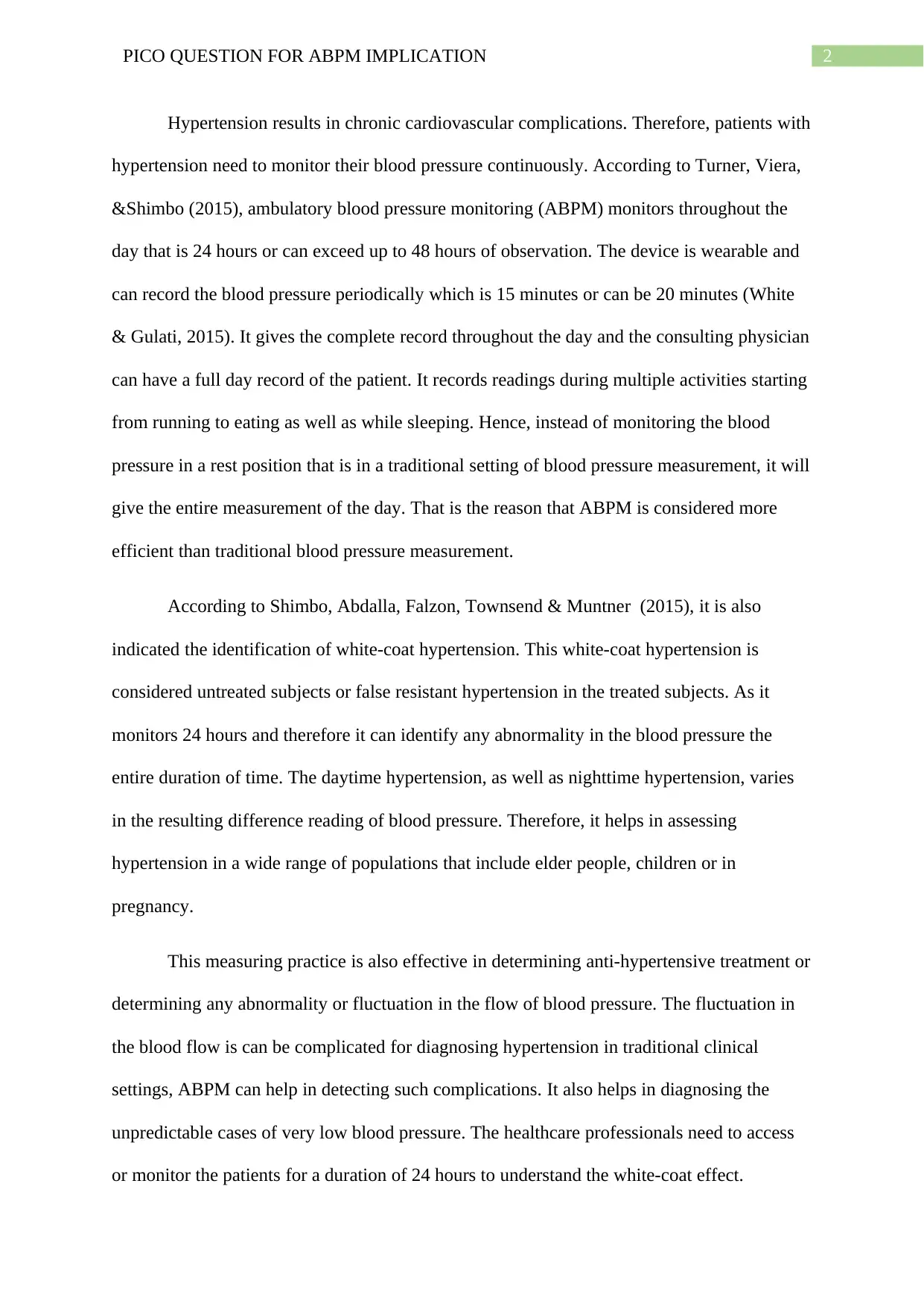
2PICO QUESTION FOR ABPM IMPLICATION
Hypertension results in chronic cardiovascular complications. Therefore, patients with
hypertension need to monitor their blood pressure continuously. According to Turner, Viera,
&Shimbo (2015), ambulatory blood pressure monitoring (ABPM) monitors throughout the
day that is 24 hours or can exceed up to 48 hours of observation. The device is wearable and
can record the blood pressure periodically which is 15 minutes or can be 20 minutes (White
& Gulati, 2015). It gives the complete record throughout the day and the consulting physician
can have a full day record of the patient. It records readings during multiple activities starting
from running to eating as well as while sleeping. Hence, instead of monitoring the blood
pressure in a rest position that is in a traditional setting of blood pressure measurement, it will
give the entire measurement of the day. That is the reason that ABPM is considered more
efficient than traditional blood pressure measurement.
According to Shimbo, Abdalla, Falzon, Townsend & Muntner (2015), it is also
indicated the identification of white-coat hypertension. This white-coat hypertension is
considered untreated subjects or false resistant hypertension in the treated subjects. As it
monitors 24 hours and therefore it can identify any abnormality in the blood pressure the
entire duration of time. The daytime hypertension, as well as nighttime hypertension, varies
in the resulting difference reading of blood pressure. Therefore, it helps in assessing
hypertension in a wide range of populations that include elder people, children or in
pregnancy.
This measuring practice is also effective in determining anti-hypertensive treatment or
determining any abnormality or fluctuation in the flow of blood pressure. The fluctuation in
the blood flow is can be complicated for diagnosing hypertension in traditional clinical
settings, ABPM can help in detecting such complications. It also helps in diagnosing the
unpredictable cases of very low blood pressure. The healthcare professionals need to access
or monitor the patients for a duration of 24 hours to understand the white-coat effect.
Hypertension results in chronic cardiovascular complications. Therefore, patients with
hypertension need to monitor their blood pressure continuously. According to Turner, Viera,
&Shimbo (2015), ambulatory blood pressure monitoring (ABPM) monitors throughout the
day that is 24 hours or can exceed up to 48 hours of observation. The device is wearable and
can record the blood pressure periodically which is 15 minutes or can be 20 minutes (White
& Gulati, 2015). It gives the complete record throughout the day and the consulting physician
can have a full day record of the patient. It records readings during multiple activities starting
from running to eating as well as while sleeping. Hence, instead of monitoring the blood
pressure in a rest position that is in a traditional setting of blood pressure measurement, it will
give the entire measurement of the day. That is the reason that ABPM is considered more
efficient than traditional blood pressure measurement.
According to Shimbo, Abdalla, Falzon, Townsend & Muntner (2015), it is also
indicated the identification of white-coat hypertension. This white-coat hypertension is
considered untreated subjects or false resistant hypertension in the treated subjects. As it
monitors 24 hours and therefore it can identify any abnormality in the blood pressure the
entire duration of time. The daytime hypertension, as well as nighttime hypertension, varies
in the resulting difference reading of blood pressure. Therefore, it helps in assessing
hypertension in a wide range of populations that include elder people, children or in
pregnancy.
This measuring practice is also effective in determining anti-hypertensive treatment or
determining any abnormality or fluctuation in the flow of blood pressure. The fluctuation in
the blood flow is can be complicated for diagnosing hypertension in traditional clinical
settings, ABPM can help in detecting such complications. It also helps in diagnosing the
unpredictable cases of very low blood pressure. The healthcare professionals need to access
or monitor the patients for a duration of 24 hours to understand the white-coat effect.
⊘ This is a preview!⊘
Do you want full access?
Subscribe today to unlock all pages.

Trusted by 1+ million students worldwide
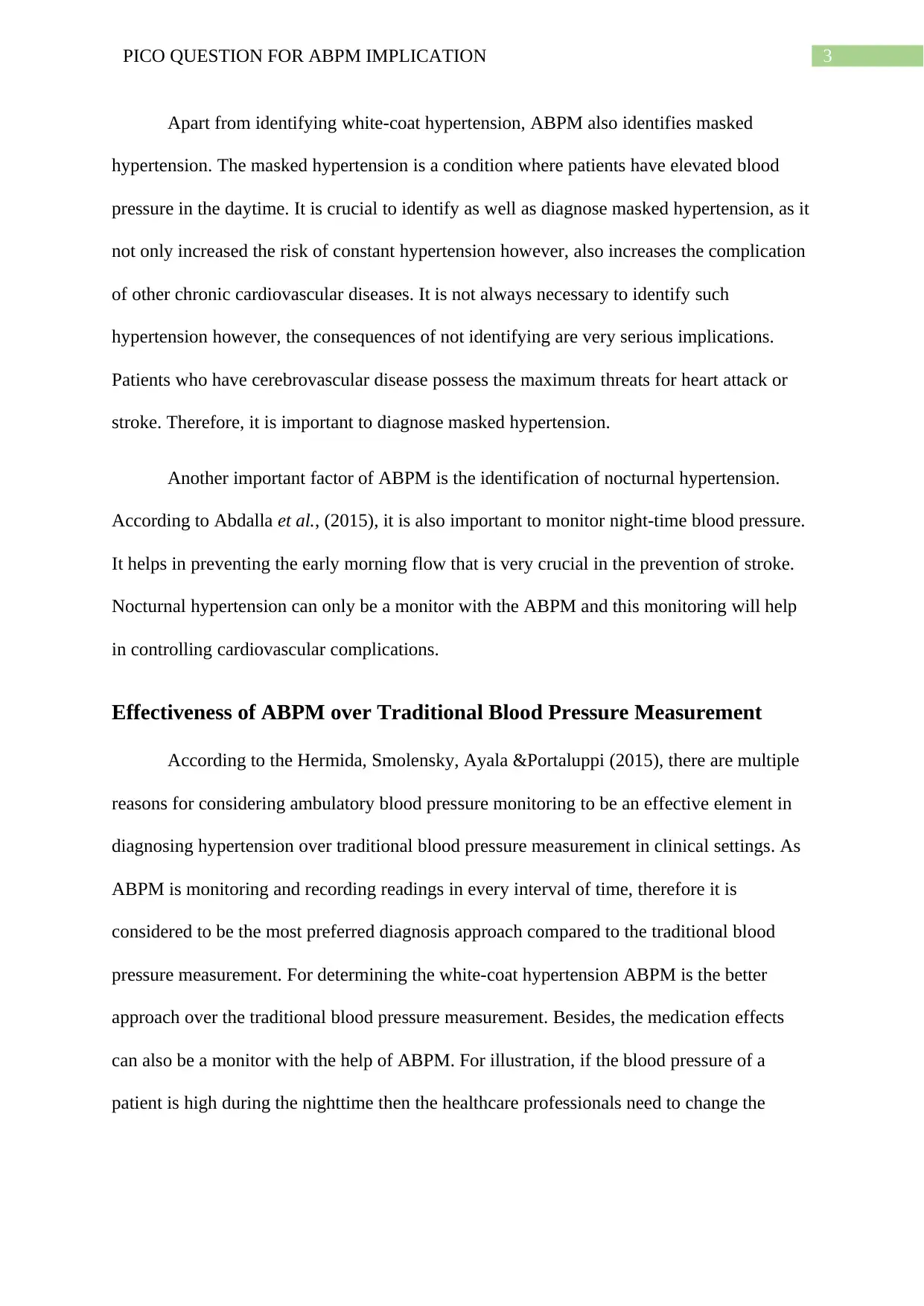
3PICO QUESTION FOR ABPM IMPLICATION
Apart from identifying white-coat hypertension, ABPM also identifies masked
hypertension. The masked hypertension is a condition where patients have elevated blood
pressure in the daytime. It is crucial to identify as well as diagnose masked hypertension, as it
not only increased the risk of constant hypertension however, also increases the complication
of other chronic cardiovascular diseases. It is not always necessary to identify such
hypertension however, the consequences of not identifying are very serious implications.
Patients who have cerebrovascular disease possess the maximum threats for heart attack or
stroke. Therefore, it is important to diagnose masked hypertension.
Another important factor of ABPM is the identification of nocturnal hypertension.
According to Abdalla et al., (2015), it is also important to monitor night-time blood pressure.
It helps in preventing the early morning flow that is very crucial in the prevention of stroke.
Nocturnal hypertension can only be a monitor with the ABPM and this monitoring will help
in controlling cardiovascular complications.
Effectiveness of ABPM over Traditional Blood Pressure Measurement
According to the Hermida, Smolensky, Ayala &Portaluppi (2015), there are multiple
reasons for considering ambulatory blood pressure monitoring to be an effective element in
diagnosing hypertension over traditional blood pressure measurement in clinical settings. As
ABPM is monitoring and recording readings in every interval of time, therefore it is
considered to be the most preferred diagnosis approach compared to the traditional blood
pressure measurement. For determining the white-coat hypertension ABPM is the better
approach over the traditional blood pressure measurement. Besides, the medication effects
can also be a monitor with the help of ABPM. For illustration, if the blood pressure of a
patient is high during the nighttime then the healthcare professionals need to change the
Apart from identifying white-coat hypertension, ABPM also identifies masked
hypertension. The masked hypertension is a condition where patients have elevated blood
pressure in the daytime. It is crucial to identify as well as diagnose masked hypertension, as it
not only increased the risk of constant hypertension however, also increases the complication
of other chronic cardiovascular diseases. It is not always necessary to identify such
hypertension however, the consequences of not identifying are very serious implications.
Patients who have cerebrovascular disease possess the maximum threats for heart attack or
stroke. Therefore, it is important to diagnose masked hypertension.
Another important factor of ABPM is the identification of nocturnal hypertension.
According to Abdalla et al., (2015), it is also important to monitor night-time blood pressure.
It helps in preventing the early morning flow that is very crucial in the prevention of stroke.
Nocturnal hypertension can only be a monitor with the ABPM and this monitoring will help
in controlling cardiovascular complications.
Effectiveness of ABPM over Traditional Blood Pressure Measurement
According to the Hermida, Smolensky, Ayala &Portaluppi (2015), there are multiple
reasons for considering ambulatory blood pressure monitoring to be an effective element in
diagnosing hypertension over traditional blood pressure measurement in clinical settings. As
ABPM is monitoring and recording readings in every interval of time, therefore it is
considered to be the most preferred diagnosis approach compared to the traditional blood
pressure measurement. For determining the white-coat hypertension ABPM is the better
approach over the traditional blood pressure measurement. Besides, the medication effects
can also be a monitor with the help of ABPM. For illustration, if the blood pressure of a
patient is high during the nighttime then the healthcare professionals need to change the
Paraphrase This Document
Need a fresh take? Get an instant paraphrase of this document with our AI Paraphraser
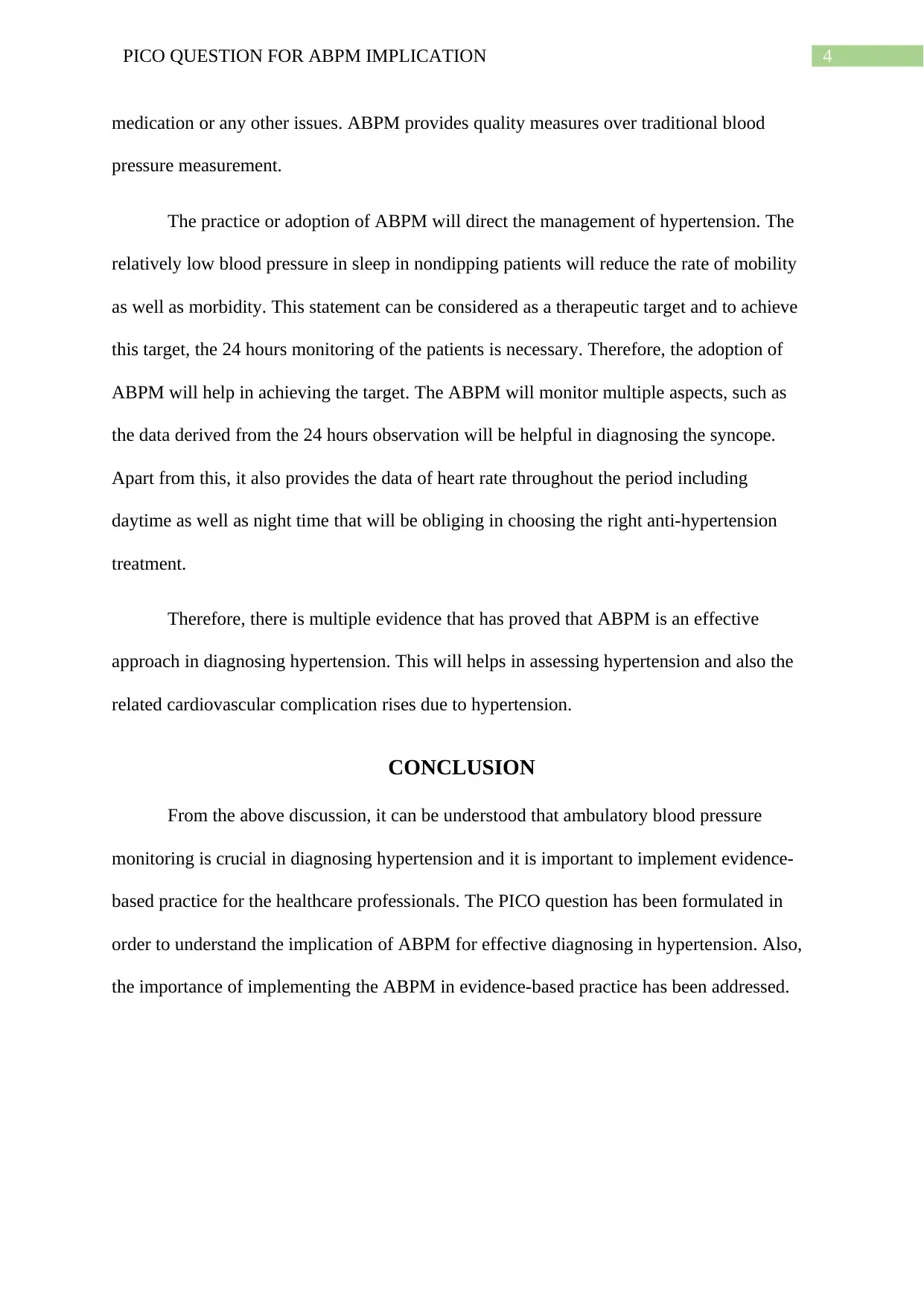
4PICO QUESTION FOR ABPM IMPLICATION
medication or any other issues. ABPM provides quality measures over traditional blood
pressure measurement.
The practice or adoption of ABPM will direct the management of hypertension. The
relatively low blood pressure in sleep in nondipping patients will reduce the rate of mobility
as well as morbidity. This statement can be considered as a therapeutic target and to achieve
this target, the 24 hours monitoring of the patients is necessary. Therefore, the adoption of
ABPM will help in achieving the target. The ABPM will monitor multiple aspects, such as
the data derived from the 24 hours observation will be helpful in diagnosing the syncope.
Apart from this, it also provides the data of heart rate throughout the period including
daytime as well as night time that will be obliging in choosing the right anti-hypertension
treatment.
Therefore, there is multiple evidence that has proved that ABPM is an effective
approach in diagnosing hypertension. This will helps in assessing hypertension and also the
related cardiovascular complication rises due to hypertension.
CONCLUSION
From the above discussion, it can be understood that ambulatory blood pressure
monitoring is crucial in diagnosing hypertension and it is important to implement evidence-
based practice for the healthcare professionals. The PICO question has been formulated in
order to understand the implication of ABPM for effective diagnosing in hypertension. Also,
the importance of implementing the ABPM in evidence-based practice has been addressed.
medication or any other issues. ABPM provides quality measures over traditional blood
pressure measurement.
The practice or adoption of ABPM will direct the management of hypertension. The
relatively low blood pressure in sleep in nondipping patients will reduce the rate of mobility
as well as morbidity. This statement can be considered as a therapeutic target and to achieve
this target, the 24 hours monitoring of the patients is necessary. Therefore, the adoption of
ABPM will help in achieving the target. The ABPM will monitor multiple aspects, such as
the data derived from the 24 hours observation will be helpful in diagnosing the syncope.
Apart from this, it also provides the data of heart rate throughout the period including
daytime as well as night time that will be obliging in choosing the right anti-hypertension
treatment.
Therefore, there is multiple evidence that has proved that ABPM is an effective
approach in diagnosing hypertension. This will helps in assessing hypertension and also the
related cardiovascular complication rises due to hypertension.
CONCLUSION
From the above discussion, it can be understood that ambulatory blood pressure
monitoring is crucial in diagnosing hypertension and it is important to implement evidence-
based practice for the healthcare professionals. The PICO question has been formulated in
order to understand the implication of ABPM for effective diagnosing in hypertension. Also,
the importance of implementing the ABPM in evidence-based practice has been addressed.
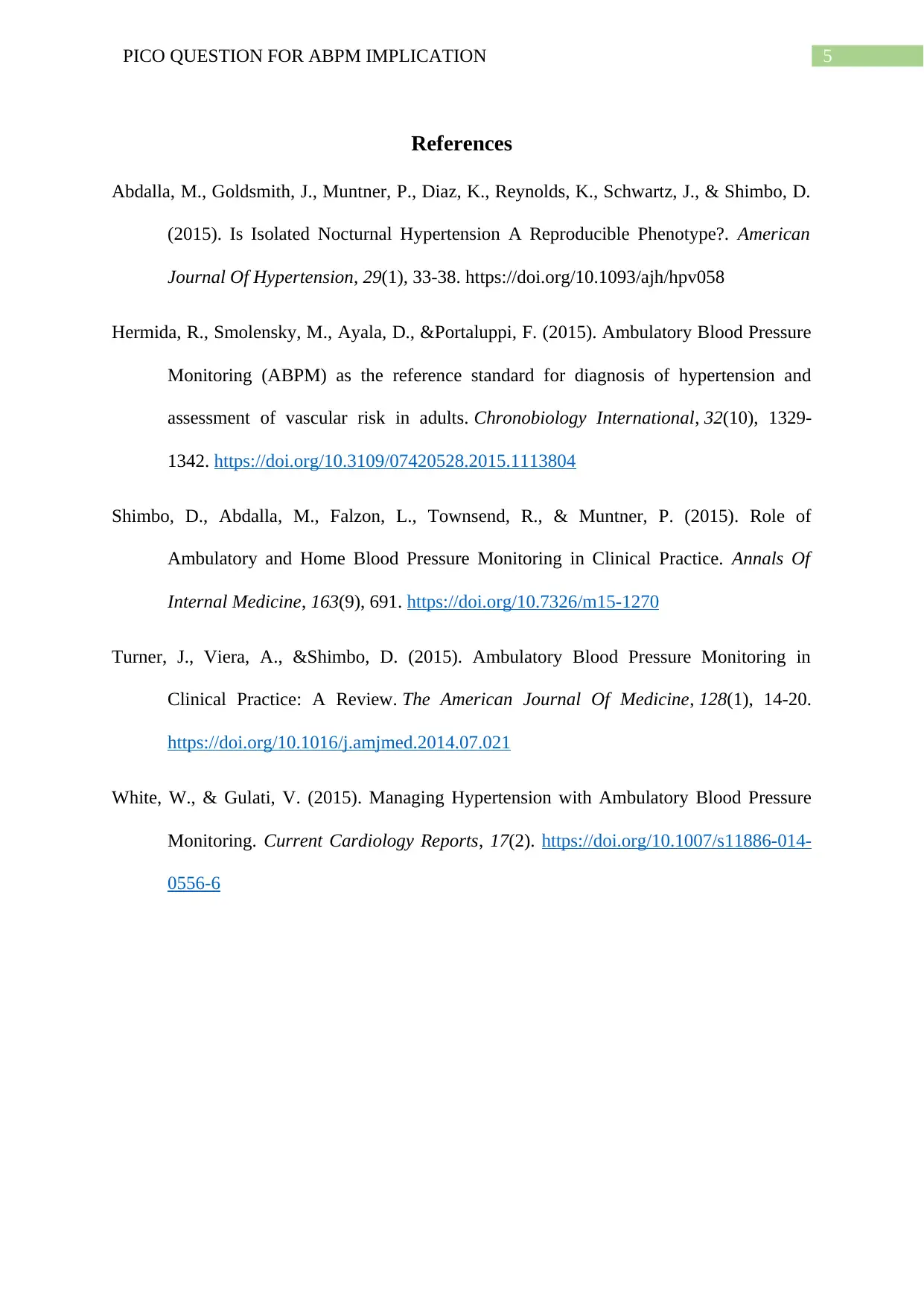
5PICO QUESTION FOR ABPM IMPLICATION
References
Abdalla, M., Goldsmith, J., Muntner, P., Diaz, K., Reynolds, K., Schwartz, J., & Shimbo, D.
(2015). Is Isolated Nocturnal Hypertension A Reproducible Phenotype?. American
Journal Of Hypertension, 29(1), 33-38. https://doi.org/10.1093/ajh/hpv058
Hermida, R., Smolensky, M., Ayala, D., &Portaluppi, F. (2015). Ambulatory Blood Pressure
Monitoring (ABPM) as the reference standard for diagnosis of hypertension and
assessment of vascular risk in adults. Chronobiology International, 32(10), 1329-
1342. https://doi.org/10.3109/07420528.2015.1113804
Shimbo, D., Abdalla, M., Falzon, L., Townsend, R., & Muntner, P. (2015). Role of
Ambulatory and Home Blood Pressure Monitoring in Clinical Practice. Annals Of
Internal Medicine, 163(9), 691. https://doi.org/10.7326/m15-1270
Turner, J., Viera, A., &Shimbo, D. (2015). Ambulatory Blood Pressure Monitoring in
Clinical Practice: A Review. The American Journal Of Medicine, 128(1), 14-20.
https://doi.org/10.1016/j.amjmed.2014.07.021
White, W., & Gulati, V. (2015). Managing Hypertension with Ambulatory Blood Pressure
Monitoring. Current Cardiology Reports, 17(2). https://doi.org/10.1007/s11886-014-
0556-6
References
Abdalla, M., Goldsmith, J., Muntner, P., Diaz, K., Reynolds, K., Schwartz, J., & Shimbo, D.
(2015). Is Isolated Nocturnal Hypertension A Reproducible Phenotype?. American
Journal Of Hypertension, 29(1), 33-38. https://doi.org/10.1093/ajh/hpv058
Hermida, R., Smolensky, M., Ayala, D., &Portaluppi, F. (2015). Ambulatory Blood Pressure
Monitoring (ABPM) as the reference standard for diagnosis of hypertension and
assessment of vascular risk in adults. Chronobiology International, 32(10), 1329-
1342. https://doi.org/10.3109/07420528.2015.1113804
Shimbo, D., Abdalla, M., Falzon, L., Townsend, R., & Muntner, P. (2015). Role of
Ambulatory and Home Blood Pressure Monitoring in Clinical Practice. Annals Of
Internal Medicine, 163(9), 691. https://doi.org/10.7326/m15-1270
Turner, J., Viera, A., &Shimbo, D. (2015). Ambulatory Blood Pressure Monitoring in
Clinical Practice: A Review. The American Journal Of Medicine, 128(1), 14-20.
https://doi.org/10.1016/j.amjmed.2014.07.021
White, W., & Gulati, V. (2015). Managing Hypertension with Ambulatory Blood Pressure
Monitoring. Current Cardiology Reports, 17(2). https://doi.org/10.1007/s11886-014-
0556-6
⊘ This is a preview!⊘
Do you want full access?
Subscribe today to unlock all pages.

Trusted by 1+ million students worldwide
1 out of 6
Related Documents
Your All-in-One AI-Powered Toolkit for Academic Success.
+13062052269
info@desklib.com
Available 24*7 on WhatsApp / Email
![[object Object]](/_next/static/media/star-bottom.7253800d.svg)
Unlock your academic potential
Copyright © 2020–2025 A2Z Services. All Rights Reserved. Developed and managed by ZUCOL.





